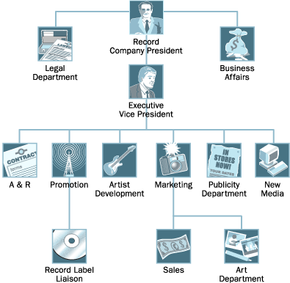Organization of a Record Label
Remember that nowadays, many record companies are huge corporations that own a variety of record labels. For the most part, these companies are located in New York, Los Angeles or Nashville. These corporations usually consist of a parent company that owns more than one record label. For example, Warner Brothers Records owns Reprise Records and Maverick Records. BMG owns Arista Records, RCA and J Records. In today's economy, most large record companies are actually huge conglomerates that own a variety of subsidiary record labels. Often, the subsidiary labels are each mini-companies operating under the umbrella of the larger corporation.
To describe the hierarchy of a record company, it's best to start at the top. The CEO (chief executive officer) is in charge of the business of the whole company. In addition, each label also has its own president. Under the president of the individual label, there are vice presidents in charge of different departments. Let's take a look at the departments that make up a major record label:
Advertisement
- A&R - The A&R (artists and repertoire) department is often considered the most glamorous department at a record label. This is because A&R is in charge of discovering new talent. A&R people work very hands-on with the artists that they "sign." (When a record label "signs" an artist, it simply means that the artist makes an exclusive contract with that record label.) They do everything from assisting with song selection to choosing the people that will produce the album to deciding where the album will be recorded. The people in this department work as the link between the recording artist and all the other departments of the record company.
- Art Department - This department is in charge of all the artwork that goes along with producing an album. This includes CD cover art, advertisements and displays at music stores.
- Artist Development - This department is responsible for planning the careers of the artists who are signed to the record label. It promotes and publicizes the artists over the course of their career. According to Music Biz Academy, many labels no longer have artist development departments. As record labels have come to see artists as products in recent years, some artist development departments have been renamed "Product Development." Many insist that this is because the emphasis in the current music business is to promote artists very heavily in the beginning of their career, as opposed to long-term planning. *If you don't want to be a "one-hit-wonder," pay close attention to how the record label views this aspect of career planning.
- Business Affairs - This department deals with the business side of things. It takes care of bookkeeping, payroll and general finances.
- Label Liaison - This is usually one person, or small group of people, who serves as the liaison between the record company's distribution company (either an entirely separate division under the huge corporate umbrella or an outside company responsible for getting the CDs into the stores) and the record company. The label liaison also helps decide when to release an album (when the album goes on sale to the public) and makes sure it doesn't conflict with any of the other labels the record company owns.
- Legal Department - This department is responsible for all the contracts that are made between the company and the artist, as well as contracts between the record label and other companies. Any legal issues that arise (such as lawsuits between an artist and the company) go through this department.
- Marketing Department - This department creates the overall marketing plan for every album that the record company will release. It helps coordinate the plans of the promotion, sales and publicity departments.
- New Media - This department is in charge of dealing with the newer aspects of the music business, including producing and promoting music videos for the artist. In addition, this department is often responsible for helping an artist create a presence on the Internet. It deals with the new technologies in which artists can stream music and music videos through the Internet.
- Promotion Department - This department's main purpose is to make sure that an artist is being played on the radio. It must get an artist's new songs on the radio in order to ensure the future success of the record company. This department makes sure that all the other departments are communicating about the best way to sell the artist to the public. The promotion department may also try to get videos played on MTV or VH1 channels. This can be the responsibility of this department or in conjunction with the New Media department.
- Publicity - This group is responsible for getting the word out about a new or established artist. It arranges for articles to be written in newspapers and magazines. They also deal with radio and television coverage of an artist. Many artists also have their own independent publicists who help coordinate publicity with this department as well.
- Sales - This department oversees the retail aspect of the record business. It works with the record store chains and other music stores to get new albums onto retailers' shelves. The sales department often coordinates these efforts with the promotion and publicity departments.
Remember that any given record label may have a slightly different organization. As large companies buy up smaller record labels, the organization of record companies changes a great deal. Most record companies have their own Web sites where you can find what labels the company owns and what artists the company is promoting. For more general information on record companies, check out Music Biz Academy and Music Business Solutions.
